This species has been observed on Reunion, Mayotte, Madagascar and Seychelles Islands
Species characteristics : This species has dark purple spots ringed with white, and a irregular washy purple border to the foot and the mantle The gills and rhinophores are white with washy purple tip A variable brown background coloration |

|
|
| Showing species characteristics... | Photo Philibert Bidgrain Reunion, Etang salé on a rocky coast, less 1 m, 17 October 2005, size 35-40 mm |
|
See more about : Sightening and mating periods
See more about : Goniobranchus cavae variability in Southwest Indian ocean
Remarks :
Presumptive identification by Bill Rudman and Nathalie Yonow
According Bill Rudman : " Specimens from Reunion Island show an incredible range of variation, including forms in which the diffuse yellow-orange spots become browner and expand to form one large brownish patch. In the most extreme form of this pattern, the purple spots become fewer and much larger and all the mantle, except for a narrow white band at the edge, becomes a uniform yellow-brown background. I had earlier separated specimens from South Africa with that colour pattern into a separate species which I called Chromodoris cf. geminus, but the photos we now have from Reunion Is, Mauritius and South Africa suggest that this is just an extreme colour variant of C. cavae.
I could of course be quite wrong, but for those who believe in parsimony, this seems to be a much more parsimonious hypothesis than 5 or 6 new species. "
In, Atlas mondial des nudibranches (Debelius, 2007) they are considered as two differents species...Goniobranchus cavae and Chromodoris cf geminus as Chromodoris sp1
In, Indo-pacific nudibranchs and seaslugs. A field guide to the World's most diverse fauna (Gosliner, 2008) we can found Chromodoris cf geminus as Chromodoris sp 12
In an earlier publication (Rudman, 1987) Rudman considered C. cavae and C. vicina (Eliot, 1904), both described from Zanzibar, East Africa, to be synonyms of C. tennentana (Kelaart, 1859), which was described from Ceylon (Sri Lanka)
Now, he still believe C. vicina is a synonym of C. tennentana but that G. cavae is a distinct species.
If you have any idea about this hypothesis, contact us...
You can read the entirely article in Chromodoris cavae by Bill Rudman
This seaslug mimics the flatworm Pseudoceros sp2, a flatworm which is found in Mauritius and Mayotte
Synonymous : (according Worms)
- Chromodoris cavae, Eliot, 1904
- Glossodoris cavae, (Eliot, 1904)
Bibliographic data :
Eliot description (1904)
"Several specimens from the East and West Coasts of Zanzibar . The following are the notes on the living animal: - Colour yellowish white, with indefinite large drab blotches laterally. Edges of mantle and foot bordered with light violet. On the back are black spots surrounded by a white line and also irregular dull orange spots. The foot is not very broad, white in colour, with a row of dull orange spots and black spots below them. The tip and anterior side of the rhinophores are purple; the lamellae are reduced to fine striations.... "
Mantle coloration variation :
- It may have yellow-orange spots, but they are larger and more diffuse than in C. tennentana, and are intermingled with the purple spots rather than restricted to the outer mantle.
- In some forms the diffuse yellow-orange spots become browner and expand to form one large brownish patch.
- In some colour extremes the purple becomes more dominant, with the rhinophore clubs and foot and mantle border becoming dark purple and the gills becoming lined with purple.
G. cavae looks like C. tennentana , C. cf geminus and C. collingwoodii. Comparaisons between the four chromodorididae is difficult, but there are some differences.
C. collingwoodii
G. cavae
Distribution
West Pacific
West Indian Ocean
Gills
Translucent with a dark brown, almost black, line down the two edges
Dark brown, sometimes with white spots.
White with purple tips
Rhinophores
Dark reddish brown with white specks
Reddish brown with a white tip
White with purple tips
Dorsum border
Bluish purple border and the white region inside has yellow spots and dark purple spots
Bluish purple border and the white region inside has yellow spots
An irregular washy purple border
A fine purple border (absent from our specimens) with a white region inside
Dorsum central area
Large orange-brown central patch scattering of fine white specks all over
Large orange-brown central patch with large purple spots each surrounded by a white ring
Large very variable in color orange-brown central patch with dark purple spots ringed with white and with sometimes orange spots
Large brownish central patch with large purplish red spots or marks, usually ringed with white.
References :
Bill Rudman Seaslug site : Sea Slug Forum : Chromodoris cavae
Nudipixel Chromodoris tennentana
Publications :
Eliot, C.N.E. (1904) On some nudibranchs from East Africa and Zanzibar . Part IV. Proceedings of the Zoological Society of London , (1904) : 380-406.
Rudman, W.B. (1987) The Chromodorididae (Opisthobranchia: Mollusca) of the Indo-West Pacific: Chromodoris epicuria, C. aureopurpurea, C. annulata, C. coi and Risbecia tryoni colour groups. Zoological Journal of the Linnean Society, 90 : 305-407.
Other photos of Goniobranchus cavae :
Philibert Bidgrain Reunion, Etang salé on a rocky coast, less 1 m, 14 October 2005, size 20-25 mm
A specimen without important brownish mantle background coloration but only some dull orange spots scattered over the mantle |
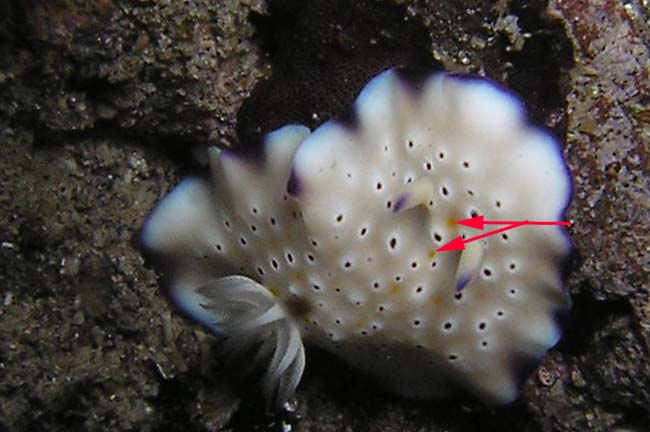 |
 |
Hugues Flodrops Reunion, Etang-Salé on a rocky coast, less 1 m, 5 April 2007, size : 40 mm. Specimen with a pale washy purple rhinophores and border to the foot and the mantle This specimen looks like pale form of Chromodoris. cf geminus |
Philibert Bidgrain Reunion, Etang-Salé on a rocky coast, less 1 m, 30 October 2006, size : 45 mm. The foot is not very broad, with a row of dull orange spots ringed with white  |
 |
 |
Philibert Bidgrain Reunion, Etang-Salé on a rocky coast, less 1 m, 30 April 2007, size : 25-30 mm. A specimen with extra numerous orange spots on the mantle without white ring. We can observed some bifurcated gills around the orange anus protuberance
|
Christophe Cadet Reunion, Etang salé on the rocky coast, less 1 m, 20 September 2009, size : 40 mm A specimen with a large number of dark purple spots ringed with white and a regular washy purple border to the foot and the mantle This seaslug mimics the flatworm Pseudoceros sp2, a flatworm which is found in Mauritius and Mayotte |
 |
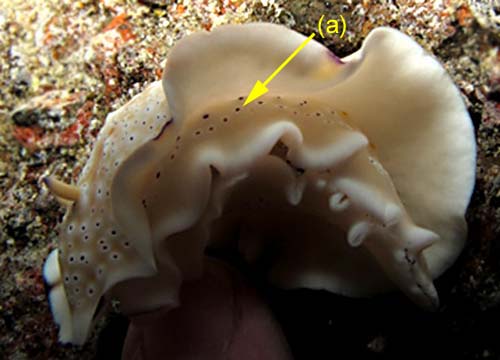 |
Hugues Flodrops Reunion, Etang-Salé on a rocky coast, less 1 m, 17 November 2010, size : 45-50 mm. The foot is not very broad, with a row of dark purple spots ringed with white (a) Two specimens with two different pattern... |
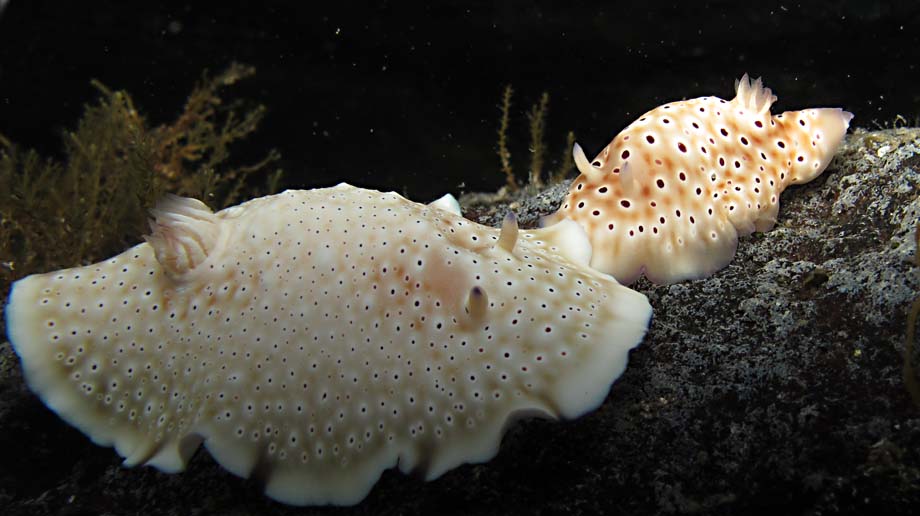 |
|
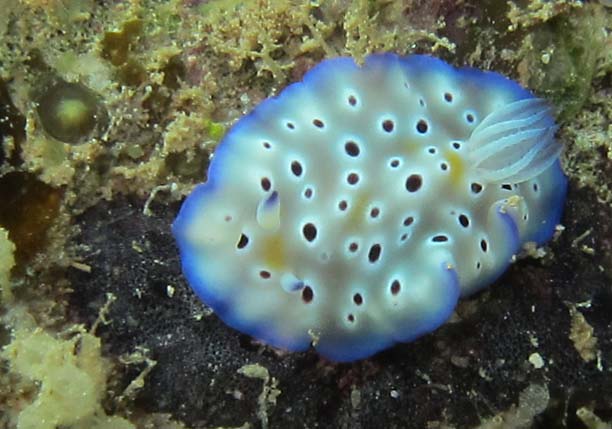 |
Norbert Verneau Mayotte, Papani, less 1 m, 31 March 32012, size : 15 mm. A small specimen with a pale washy purple rhinophores and border to the foot and the mantle
|
Christophe Mason-Parker Seychelles, Lilot, 16 m, 5 January 2013, size : 60 mm. Specimen with : - a pale washy purple rhinophores and border to the foot and the mantle - an intense brownish coloration on the mantle This specimen looks like Chromodoris. cf geminus |
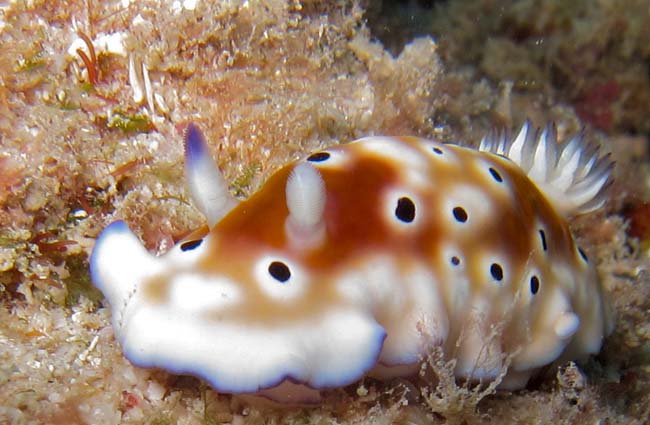 |
 |
Nathalie Bazard Madagascar, Nosy Bé, 1 October 2016
|
More photos from Indian Ocean
See more about : Goniobranchus cavae variability in Southwest Indian ocean
Reunion, gill detail of Goniobranchus cavae, at Etang salé, by Christophe Cadet
Reunion, Goniobranchus cavae with dark purple coloration, at Etang salé, by Philibert Bidgrain
Reunion, a juvenile of Goniobranchus cavae, at Etang salé, by Christophe Cadet
Reunion, Goniobranchus cavae with important purple border, at Etang salé, by Hugues Flodrops

